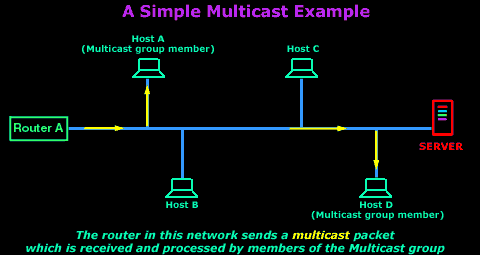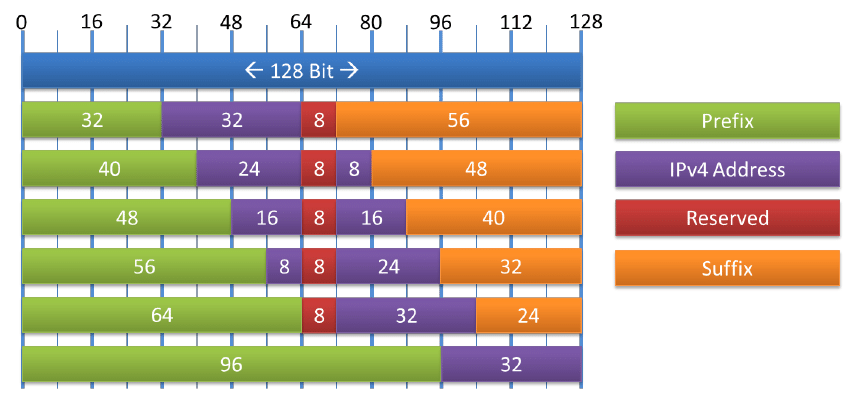Overview
IP multicast is a technique for one-to-many and many-to-many real-time communication over an IP infrastructure in a network. It scales to a larger receiver population by requiring neither prior knowledge of a receiver's identity nor prior knowledge of the number of receivers. Multicast uses network infrastructure efficiently by requiring the source to send a packet only once, even if it needs to be delivered to a large number of receivers. The nodes in the network (typically network switches and routers) take care of replicating the packet to reach multiple receivers such that messages are sent over each link of the network only once.
What is Multicast ?
In computer networking, multicast is group communication where data transmission is addressed to a group of destination computers simultaneously.Multicast can be one-to-many or many-to-many distribution. Multicast should not be confused with physical layer point-to-multi point communication.

Which version of IP supports Multicast ?
Why we need Multicast ? ....and its Practical application?
Protocols associated with IP multicast include Internet Group Management Protocol, Protocol Independent Multicast and Multicast VLAN Registration. IGMP snooping is used to manage IP multicast traffic on layer-2 networks.
What are other or different type of CAST ? in the IPv6 ...
1. Unicast - to transmit a single message to a single receiver.
2. Multicast - to transmit a single message to a select group of recipients. A simple example of multi casting is sending an e-mail message to a mailing list. Teleconferencing and videoconferencing also use multicasting, and often use proprietary protocols in addition to the existing multicast standards (IP Multicast, Mbone, etc).
3. Narrowcast - to transmit a single message to a select group of recipients who have subscribed. Narrowcast is similar to Multicast and the two terms are often used interchangeably. However, narrowcast refers to the business model whereas multicast refers to the actual technology used to transmit the data. Cable television is an example of narrowcasting since the cable TV signals are sent only to homes that have subscribed to the cable service. Perhaps the best example of narrowcasting are e-mail lists where messages are sent only to individuals who subscribe to the list.
4. Broadcast - to transmit a single message to everyone connected to a network. Note that multicasting refers to sending a message to a select group whereas broadcasting refers to sending a message to everyone connected to a network.
5. Anycast (IPv6) - to transmit a single message to the nearest of a group of receivers. Anycast is used in IPv6 as a method of updating routing tables, as in the 6 to 4 Anycast protocol. One host initiates an update of a router table for a group of hosts, sending the data to the nearest host. That host then sends the message on to its nearest router until all the routing tables in that group are updated.
Why there is no Subnetting in IPv6 ? What's the equivalent or Replacement?
1: IPv6 addresses are 128-bit hexadecimal numbers
The IPv4 addresses we are all used to seeing are made up of four numerical octets that combine to form a 32-bit address. IPv6 addresses look nothing like IPv4 addresses. IPv6 addresses are 128 bits in length and are made up of hexadecimal characters.
In IPv4, each octet consists of a decimal number ranging from 0 to 255. These numbers are typically separated by periods. In IPv6, addresses are expressed as a series of eight 4-character hexadecimal numbers, which represent 16 bits each (for a total of 128 bits). As we'll see in a minute, IPv6 addresses can sometimes be abbreviated in a way that allows them to be expressed with fewer characters.
2: Link local unicast addresses are easy to identify
IPv6 reserves certain headers for different types of addresses. Probably the best known example of this is that link local unicast addresses always begin with FE80. Similarly, multicast addresses always begin with FF0x, where the x is a placeholder representing a number from 1 to 8.
3: Leading zeros are suppressed
Because of their long bit lengths, IPv6 addresses tend to contain a lot of zeros. When a section of an address starts with one or more zeros, those zeros are nothing more than placeholders. So any leading zeros can be suppressed. To get a better idea of what I mean, look at this address:
FE80:CD00:0000:0CDE:1257:0000:211E:729C
If this were a real address, any leading zero within a section could be suppressed. The result would look like this:
FE80:CD00:0:CDE:1257:0:211E:729C
As you can see, suppressing leading zeros goes a long way toward shortening the address.
4: Inline zeros can sometimes be suppressed
Real IPv6 addresses tend to contain long sections of nothing but zeros, which can also be suppressed. For example, consider the address shown below:
FE80:CD00:0000:0000:0000:0000:211E:729C
In this address, there are four sequential sections separated by zeros. Rather than simply suppressing the leading zeros, you can get rid of all of the sequential zeros and replace them with two colons. The two colons tell the operating system that everything in between them is a zero. The address shown above then becomes:
FE80:CD00::211E:729C
You must remember two things about inline zero suppression. First, you can suppress a section only if it contains nothing but zeros. For example, you will notice that the second part of the address shown above still contains some trailing zeros. Those zeros were retained because there are non-zero characters in the section. Second, you can use the double colon notation only once in any given address.
5: Loopback addresses don't even look like addresses
In IPv4, a designated address known as a loopback address points to the local machine. The loopback address for any IPv4-enabled device is 127.0.0.1.
Like IPv4, there is also a designated loopback address for IPv6:
0000:0000:0000:0000:0000:0000:0000:0001
Once all of the zeros have been suppressed, however, the IPv6 loopback address doesn't even look like a valid address. The loopback address is usually expressed as ::1.
6: You don't need a traditional subnet mask
In IPv4, every IP address comes with a corresponding subnet mask. IPv6 also uses subnets, but the subnet ID is built into the address.
In an IPv6 address, the first 48 bits are the network prefix. The next 16 bits are the subnet ID and are used for defining subnets. The last 64 bits are the interface identifier (which is also known as the Interface ID or the Device ID).
If necessary, the bits that are normally reserved for the Device ID can be used for additional subnet masking. However, this is normally not necessary, as using a 16-bit subnet and a 64-bit device ID provides for 65,535 subnets with quintillions of possible device IDs per subnet. Still, some organizations are already going beyond 16-bit subnet IDs.
7: DNS is still a valid technology
In IPv4, Host (A) records are used to map an IP address to a host name. DNS is still used in IPv6, but Host (A) records are not used by IPv6 addresses. Instead, IPv6 uses AAAA resource records, which are sometimes referred to as Quad A records. The domain ip6.arpa is used for reverse hostname resolution.
8: IPv6 can tunnel its way across IPv4 networks
One of the things that has caused IPv6 adoption to take so long is that IPv6 is not generally compatible with IPv4 networks. As a result, a number of transition technologies use tunneling to facilitate cross network compatibility. Two such technologies are Teredo and 6to4. Although these technologies work in different ways, the basic idea is that both encapsulate IPv6 packets inside IPv4 packets. That way, IPv6 traffic can flow across an IPv4 network. Keep in mind, however, that tunnel endpoints are required on both ends to encapsulate and extract the IPv6 packets.
9: You might already be using IPv6
Beginning with Windows Vista, Microsoft began installing and enabling IPv6 by default. Because the Windows implementation of IPv6 is self-configuring, your computers could be broadcasting IPv6 traffic without your even knowing it. Of course, this doesn't necessarily mean that you can abandon IPv4. Not all switches and routers support IPv6, just as some applications contain hard-coded references to IPv4 addresses.
10: Windows doesn't fully support IPv6
It's kind of ironic, but as hard as Microsoft has been pushing IPv6 adoption, Windows does not fully support IPv6 in all the ways you might expect. For example, in Windows, it is possible to include an IP address within a Universal Naming Convention (\\127.0.0.1\C$, for example). However, you can't do this with IPv6 addresses because when Windows sees a colon, it assumes you're referencing a drive letter.
To work around this issue, Microsoft has established a special domain for IPv6 address translation. If you want to include an IPv6 address within a Universal Naming Convention, you must replace the colons with dashes and append .ipv6 to the end of the address — for example, FE80-AB00—200D-617B ipv6.

Analyze IPv4 vs IPv6 - HEADERS ?
• IPv6 header is much simpler than IPv4 header.
• The size of IPv6 header is much bigger than that of IPv4 header, because of IPv6 address size. IPv4 addresses are 32bit binary numbers and IPv6 addresses are 128 bit binary numbers.
• In IPv4 header, the source and destination IPv4 addresses are 32 bit binary numbers. In IPv6 header, source and destination IPv6 addresses are 128 bit binary numbers.
• IPv4 header includes space for IPv4 options. In IPv6 header, we have a similar feature known as extension header. IPv4 data gram headers are normally 20-byte in length. But we can include IPv4 option values also along with an IPv4 header. In IPv6 header we do not have options, but have extension headers.
• The fields in the IPv4 header such as IHL (Internet Header Length), identification, flags are not present in IPv6 header.
• Time-to-Live (TTL), a field in IPv4 header, typically used for preventing routing loops, is renamed to it's exact meaning, "Hop Limit".





No comments:
Post a Comment